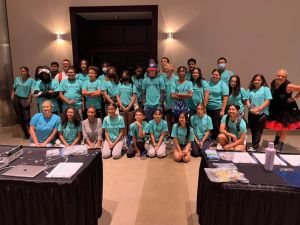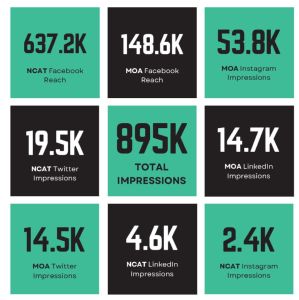Staffers at the National Center for Autonomous Technologies (NCAT) not only coordinated the massive Experience STEAM event at the Mall of America in August, they released a detailed 65-page Experience STEAM Impact Report of what worked and what didn’t to help principal investigators of Advanced Technological Education (ATE) projects and centers plan large-scale, collaborative outreach events.
“Experience STEAM was a first-of-its-kind-event with a tremendous amount of challenges and successes. We believe that between the best practices and lessons learned, a great framework for similar NSF ATE events in other markets has been built,” the report states. ATE projects and centers receive grants from the National Science Foundation’s ATE program.

Twenty-six ATE projects and centers were among the 57 corporations, nonprofit organizations, and academic institutions that partnered with NCAT on the dozens of hands-on learning experiences NCAT calls “activations” at the Minnesota mall that 394,120 people visited from August 10 to 14, 2022. (See “ATE centers show off their stuff at Mall of America”)
Jonathan Beck, NCAT executive director, calls Experience STEAM “a revolutionary approach to educational outreach. NCAT believes experiential learning provided by two-year technician education is a driving force in advancing social and economic mobility.”
The Experience STEAM event at the Mall of America “was created to spark excitement in STEAM (science, technology, engineering, arts, math) concepts, education, and careers.”
Next Test of “Revolutionary Approach” to Outreach
NCAT is testing this approach again—albeit on a smaller scale—with Experience Northland Aerospace on February 24 at Northland Community and Technical College, the host institution for NCAT. Beck says this iteration aims “to create deep connections” between the region’s residents and the technician education programs at Northland.
Based on pre-registration, this local event is off to a strong start. All 550 activity slots from 9 a.m. to 3 p.m. for students in grades 7 to 12 were filled by late January. The 86,000-square-foot aerospace facility will be open to the community in the evening (without reservations) for free activities like virtual reality drone races and lessons in programming, riveting joints, and constructing pneumatic systems.
In an email Beck explained why NCAT is investing in this highly interactive, in-person recruitment model.
“Experience STEAM is a concept that supports the ATE mission to promote technician careers and the public image of advanced technology fields. The Experience STEAM concept supports thinking differently about systemic reform, broad outreach, and community-building to strengthen the talent pipeline to the skilled technical workforce.
“Experience Northland Aerospace is using best practices from the Experience STEAM concept and bringing it to rural America in a model that can be replicated based on a local community. Northland is positioned in the Red River Valley Region, which has been called the Silicon Valley for Drones. This kind of technology innovation isn’t typical for rural communities. The workforce demands are growing in this region.
“Northrop Grumman, a strong partner in the region, will be visiting Northland the week prior to present information on significant increases in UAS maintenance positions that need to be filled by September 2023. NCAT is proud to support Northland, which is helping to create a replicable model. This directly supports the talent pipeline development many organizations are searching for throughout the nation,” he wrote.
Experience STEAM Data & Analysis

The Experience STEAM Impact Report offers data, analysis, and tips to avoid the challenges NCAT encountered.
Some of the positive outcomes NCAT reports are based on survey data. For example, prior to attending one of the 14 camps 16% of the 146 secondary and postsecondary students reported they were not interested in STEAM. That shifted to 4% afterward. The number of students who indicated that they were interested or very interested in STEAM improved from 64% to 80% of participants. The somewhat interested category had 16% of participants before and after the camps.
The report notes that NCAT staffers took “mindful steps to facilitate and encourage participation among communities historically underrepresented in STEM and technician education, including Latinx, Black, Indigenous, and people of color, veterans, non-traditional age students, and physically disabled individuals.”
Diversity, Equity & Inclusion Accomplishments
Successes in line with these goals include
- 20 members of the Boys & Girls Club of Central Minnesota attending the Electric Scooter Build Workshop offered by SpaceTEC and MakerTEC.
- 450 volunteer slots being filled to staff the event.
- 270 of the volunteer slots being filled by youths connected with Earn as You Learn who were paid $100 for 4.5-hour shifts as ambassadors who helped with the activations and guided mall visitors to the various STEAM exhibits.
- $122,500 raised by the Northland Foundation to help cover the cost of the free events.
- 224 free Metro bus rides for attendees thanks to the NCAT’s partnership with the municipal transit authority.
- 249 students on 61 teams from 20 states and Canada participated in a VEX robotics competition.
- 3 of 12 STEM Guitar Workshop participants were military veterans.
Perhaps NCAT’s biggest success was its social media blitz with 895,250 impressions seen by people across multiple platforms from April to August 2022. (See illustration for details.)
The NCAT team makes the point that activities that attracted just a few people made important impacts. For example only 12 students participated in the Drone Business Plan Competition; however, 10 of the participants were from low-income Minneapolis neighborhoods. “The lasting value of the Northland Drone Business Plan Competition is the mental shift encouraged by creating an environment where critical thinking and curiosity were encouraged and participants were provided tools for success. Armed with this expanded worldview, participants can re-enter their communities with the methodology to create meaningful change,” the report states.
The report mentions multiple challenges. One that influenced everything was timing. It was early 2022 when NCAT was invited to do an educational program at the Mall of America as part of the mall’s 30th anniversary celebration kickoff in August. Among the recommendations shared on the Lessons Learned list is to begin planning large outreach activities 12 months in advance in order to connect with partners and write grant proposals for funding.
In a 2022 interview Aaron Sykes, NCAT’s STEM outreach coordinator, explained the ATE center’s connection to the mall in suburban Bloomington, Minnesota, 300 miles from rural Thief River Falls where NCAT is located at Northland Community and Technical College. Conversations between NCAT and mall staffers began several years ago with a veterans outreach program that NCAT organized with the Minnesota National Guard that had to be cancelled due to COVID.
A less energetic and intrepid team might have passed on the daunting offer to lead a mall-wide STEM education event. However, Sykes said the team at NCAT decided “This opportunity gives us a chance to meet people where they are at, literally ... [and to] give them as little barriers as possible to have these value-added conversations.”
Growth from Challenges
With less than eight months to prepare NCAT personnel immediately began emailing and calling to summon people and resources from among the ATE community and the numerous regional institutions and national agencies it has as collaborators.
The STEAM Mapping Project developed with the GeoTech Center is an example of the resources built to address challenges. In this case the problem was finding STEM organizations that NCAT could engage with to encourage attendance at the event. “We couldn’t find a single unified source of local STEAM opportunities,” the NCAT team reported. GEO Tech Director Vince DiNoto, who is also NCAT co-principal investigator, along with NCAT staffers worked with SciMathMN, a Minnesota-based STEM nonprofit, and The Works Museum, an interactive children’s museum, to identify STEM organizations. As a result “SciMathMN used this development to re-engage several other STEM communities,” the report states.
Early in 2022 NCAT had no connections with grassroots community organizations in the St. Paul-Minneapolis metropolitan area. By August it had established relationships with 46 Minnesota organizations to increase participation of historically underrepresented populations in STEM education and careers.
In the report Chelsea Bladow, who was NCAT Equity & Inclusion Communications director until mid-January 2023, explains what happened: “Working with DEI&B (diversity, equity, inclusion, and belonging) professionals was an opportunity for growth amongst the NCAT team. The experience helped us better understand the nuanced landscape of working with historically underrepresented communities in STEM and technician education. In order to remove barriers, it was important for us to know and understand what the barriers were. Working with DEI&B organizations not only helped us do that but engraved the practices into everything we do at NCAT.”

 Subscribe
Subscribe


 See More ATE Impacts
See More ATE Impacts

Comments
There are no comments yet for this entry. Please Log In to post one.